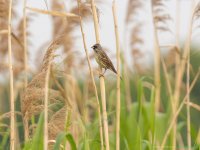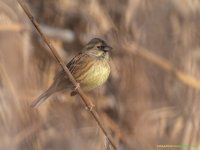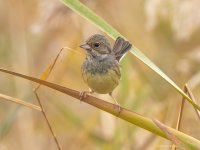-
Welcome to BirdForum, the internet's largest birding community with thousands of members from all over the world. The forums are dedicated to wild birds, birding, binoculars and equipment and all that goes with it.
Please register for an account to take part in the discussions in the forum, post your pictures in the gallery and more.
You are using an out of date browser. It may not display this or other websites correctly.
You should upgrade or use an alternative browser.
You should upgrade or use an alternative browser.
Black-faced Bunting, which subspecies? East of China. (1 Viewer)
- Thread starter deanman
- Start date
More options
Who Replied?Masked or Black-faced Bunting...as i understand it spodo has a grey hood, perso has a yellow throat and a less grey head. I think an adult male black-faced.
More expertised ppl will hopefully join soon.
edit: they did: I apologize for the quick and erroneous conclusion.
Cheers, G
More expertised ppl will hopefully join soon.
edit: they did: I apologize for the quick and erroneous conclusion.
Cheers, G
Last edited:
There are three ssp of Black-faced Bunting, E. spodocephala: spodocephala, sordida and personata. The first two have a grey bonnet down to the breast. Your bird is a male personata - which is sometimes split as 'Masked Bunting'.
This is the ssp which we have in Japan (apart from accidental spodocephala). Most of the birds wintering in my area in central Japan (near Osaka) are more intensely coloured than your bird (they arrive early and leave late), but some are like yours - the yellow and grey of our bird are both paler than they can be. I wonder if the paler birds (who nonetheless have a clear mask and are not female) are 2cy birds, but I don't know - it might just be individual or hormonal variation.
If you have Mark Brazil's 'Birds of East Asia', then the illustration of personata is incorrect, since the black on the face comes to behind the eye to make a mask, and is not just a dot behind the bill as Brazil shows.
This is the ssp which we have in Japan (apart from accidental spodocephala). Most of the birds wintering in my area in central Japan (near Osaka) are more intensely coloured than your bird (they arrive early and leave late), but some are like yours - the yellow and grey of our bird are both paler than they can be. I wonder if the paler birds (who nonetheless have a clear mask and are not female) are 2cy birds, but I don't know - it might just be individual or hormonal variation.
If you have Mark Brazil's 'Birds of East Asia', then the illustration of personata is incorrect, since the black on the face comes to behind the eye to make a mask, and is not just a dot behind the bill as Brazil shows.
Thanks a lot.Masked or Black-faced Bunting...as i understand it spodo has a grey hood, perso has a yellow throat and a less grey head. I think an adult male black-faced.
More expertised ppl will hopefully join soon.
edit: they did: I apologize for the quick and erroneous conclusion.
Cheers, G
Thanks MacNara, Do you have the similar photos like this paler birds. Tks.There are three ssp of Black-faced Bunting, E. spodocephala: spodocephala, sordida and personata. The first two have a grey bonnet down to the breast. Your bird is a male personata - which is sometimes split as 'Masked Bunting'.
This is the ssp which we have in Japan (apart from accidental spodocephala). Most of the birds wintering in my area in central Japan (near Osaka) are more intensely coloured than your bird (they arrive early and leave late), but some are like yours - the yellow and grey of our bird are both paler than they can be. I wonder if the paler birds (who nonetheless have a clear mask and are not female) are 2cy birds, but I don't know - it might just be individual or hormonal variation.
If you have Mark Brazil's 'Birds of East Asia', then the illustration of personata is incorrect, since the black on the face comes to behind the eye to make a mask, and is not just a dot behind the bill as Brazil shows.
Firstly, let me say that I was a bit extreme in my criticism of the illustration in Birds of East Asia. Some birds do look like the adult male depicted, but fully developed males have a full mask which goes around the eye, and gives the bird its new name, and so an illustration of this would have been better in my opinion.
With the yellow colouring, the light makes a difference to appearance. Anyway attached (all different individuals) 1 and 2 are bright birds. Then 3, 4 and 5 are duller birds. The last one looks like your bird in my opinion.
Presumably the difference has something to do with age. And I suppose it might also have something to do with dominance. But I'm not very good at details like that.
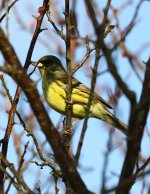
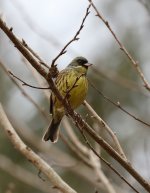
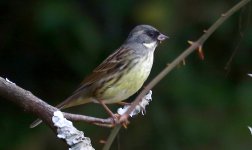
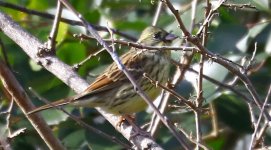
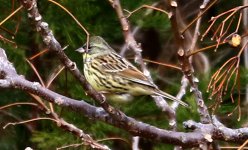
With the yellow colouring, the light makes a difference to appearance. Anyway attached (all different individuals) 1 and 2 are bright birds. Then 3, 4 and 5 are duller birds. The last one looks like your bird in my opinion.
Presumably the difference has something to do with age. And I suppose it might also have something to do with dominance. But I'm not very good at details like that.





johnallcock
Well-known member
I'm not sure the situation with Black-faced Bunting is quite as straight-forward as it appears. I often (in Hong Kong) see birds with grey head and yellow throat/submoustachial, superficially resembling personata. Yet there are no confirmed records of personata here, and only spodocephala is known to occur (although it's possible that we overlook personata due to confusion of ID). These birds are all in transitional body moult, probably young males moulting into their first breeding plumage (so a bit later moulting than older birds).
The throat and submoustachial in the original post are sullied with grey, not pure yellow as one may expect from personata. I think it may be one of these transitional spodocephala.
I can't find many photos to illustrate my points that are away from regions where personata could also occur. But see this bird from Mongolia as an example:
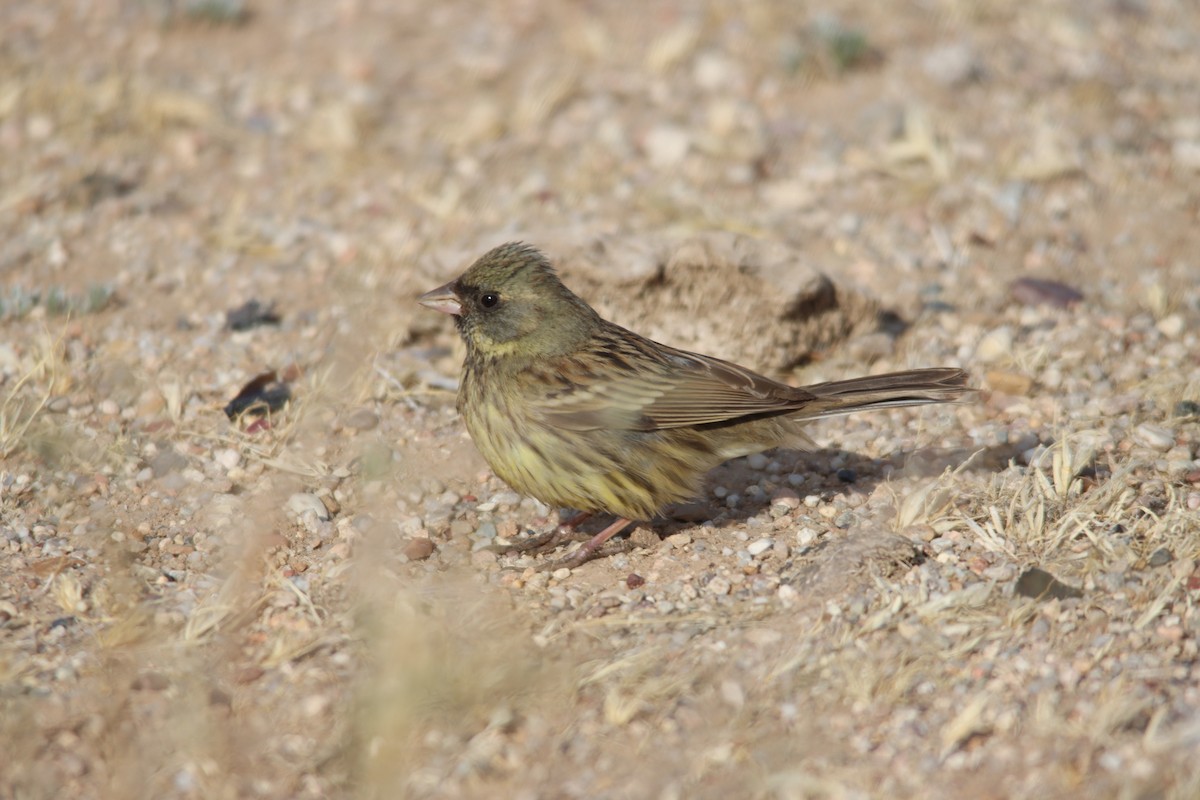
 macaulaylibrary.org
macaulaylibrary.org
The throat and submoustachial in the original post are sullied with grey, not pure yellow as one may expect from personata. I think it may be one of these transitional spodocephala.
I can't find many photos to illustrate my points that are away from regions where personata could also occur. But see this bird from Mongolia as an example:
ML446608221 Black-faced Bunting Macaulay Library
Macaulay Library ML446608221; © Tsolmon Avirmed; Dornogovi, Mongolia
Hi John; That's a very good observation. I have no experience of ssp spodocephala which is occasional at Hegura, but not elsewhere in Japan as far as I know. I wonder if it might be the case that younger birds of the various ssp resemble each other more than the adults do?
As regards your point on the colouring of deanman's bird, I would like to make two observations.
1. If you copy and open deanman's photo in Photoshop and check the levels, you can see that it is a bit overexposed. Photo one below shows the original. If you correct the levels by moving the black point to the first black pixel, which in this case because of overexposure makes the photo darker, then you get photo two, in which the bird is clearly yellower. (I've posted in other threads about adjustments in digital photos, so I won't repeat myself, but this is a perfectly legitimate move; indeed checking and adjusting the levels is something you should regularly do - NB I did not adjust the saturation to boost the yellow which some might consider illegitimate.)
2. I found the photo shown as photo three below which I took in February this year. It's much less yellow than most of our birds here (though there are some like this from time to time, as I said in my earlier post), and it seems to match deanman's bird in the balance of yellowness and greyness to my eye; I'd be interested in your view. There is absolutely no reason to think that ssp spodocephala is involved.
Also looking back at various photos, there is quite a lot of variation in these birds. Just for fun, I have attached two more. Photo four shows a bird with a yellow throat, but underparts apparently lacking in yellow. And photo five shows a bird with a spectacularly yellow throat but much less yellow elsewhere.
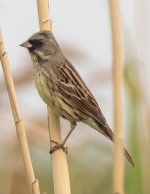
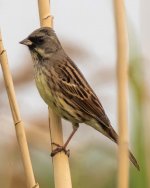
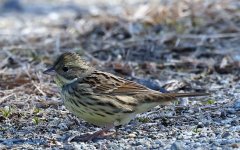
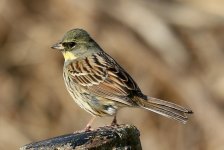
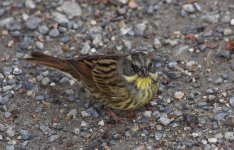
As regards your point on the colouring of deanman's bird, I would like to make two observations.
1. If you copy and open deanman's photo in Photoshop and check the levels, you can see that it is a bit overexposed. Photo one below shows the original. If you correct the levels by moving the black point to the first black pixel, which in this case because of overexposure makes the photo darker, then you get photo two, in which the bird is clearly yellower. (I've posted in other threads about adjustments in digital photos, so I won't repeat myself, but this is a perfectly legitimate move; indeed checking and adjusting the levels is something you should regularly do - NB I did not adjust the saturation to boost the yellow which some might consider illegitimate.)
2. I found the photo shown as photo three below which I took in February this year. It's much less yellow than most of our birds here (though there are some like this from time to time, as I said in my earlier post), and it seems to match deanman's bird in the balance of yellowness and greyness to my eye; I'd be interested in your view. There is absolutely no reason to think that ssp spodocephala is involved.
Also looking back at various photos, there is quite a lot of variation in these birds. Just for fun, I have attached two more. Photo four shows a bird with a yellow throat, but underparts apparently lacking in yellow. And photo five shows a bird with a spectacularly yellow throat but much less yellow elsewhere.





johnallcock
Well-known member
I'm surprised that you think there is no reason to consider spodocephala here. It is by far the most numerous taxon in eastern China, where the photo was taken. I think it is relevant to ask whether the expected taxon can ever show this head pattern, rather than assuming it is the rarer taxon.
I'm not sure the yellow saturation is useful as an ID criteria either. There has been previous confusion between spodocephala and sordida regarding the saturation of yellow in the plumage. Spodocephala has more yellow than some literature suggests.
Regarding deanman's bird, I would say that the submoustachial is quite grey and the throat is streaked dark. This is apparent on the original photo and your adjusted version. Would you expect this on a male personata? The females you have posted in your earlier replies show a degree of streaking on the throat (but still clean yellow on the submoustachial), but the males seem quite clean yellow on the throat and some even lack the darker malar.
It's an interesting bird and a useful discussion about a subject that I haven't seen covered elsewhere before.
I'm not sure the yellow saturation is useful as an ID criteria either. There has been previous confusion between spodocephala and sordida regarding the saturation of yellow in the plumage. Spodocephala has more yellow than some literature suggests.
Regarding deanman's bird, I would say that the submoustachial is quite grey and the throat is streaked dark. This is apparent on the original photo and your adjusted version. Would you expect this on a male personata? The females you have posted in your earlier replies show a degree of streaking on the throat (but still clean yellow on the submoustachial), but the males seem quite clean yellow on the throat and some even lack the darker malar.
It's an interesting bird and a useful discussion about a subject that I haven't seen covered elsewhere before.
Sorry John, I wasn't clear.I'm surprised that you think there is no reason to consider spodocephala here.
I meant that for my photo three in post #9, taken near my house ('here') and which I think looks a lot like deanman's bird, there is no reason to consider ssp spodocephala in my opinion since nothing that looks like adult ssp spodocephala has been seen in this area to the best of my knowledge (over fifteen years). I wasn't referring to deanman's bird.
On the contrary, I was trying to say that your point about deanman's bird was interesting and that if someone with your experience thinks it's possible, then it might be ssp spodocephala after all. But I thought that my bird three nonetheless looked similar to deanman's bird in colouring (and has streaking on the throat). And I was just throwing that out as an observation.
As you imply, I think, in your final sentence, it would be interesting to hear from others about variation. In my area, this bird is an extremely common winter visitor, and photos are a bit random in that I tend to take pictures of birds that strike the eye, or any old bird on a day when nothing else shows. But I've never done any systematic survey trying to gather as wide a range as possible in a particular period; maybe I'll make that a project for next year.
It would be interesting, for example, if deanman had photos of other birds from the same area and the same time period to compare with the photo he posted.
John Allcock said:
I often (in Hong Kong) see birds with grey head and yellow throat/submoustachial, superficially resembling personata. Yet there are no confirmed records of personata here, and only spodocephala is known to occur (although it's possible that we overlook personata due to confusion of ID).
I wonder how you would confirm personata in the situation where it was mixed with spodocephala, if certain ages overlap in looks (i.e what's the difference between 'superficially resembling personata' and 'resembling personata' and 'being personata').
Apologies for my misleading wording in the earlier post.
Last edited:
This thread hasn't yet ended in a satisfactory resolution for the OP Deanman.
I'll try to summarise in the hope that someone else with more (or different) experience of these ssp might join in.
In central Japan where I am, E. spodocephala ssp personata are a very common winter bird. I have no personal experience of the other two ssp, spodocephala and sordida.
For me (not a professional, or even an expert amateur, of which there are many on BF), the original bird would be OK for a personata male in my location, though a bit paler than many. I thought from books and online casual viewing that ssp spodocephala with that much grey on the head and black around the mouth would also have a grey bib, and that it would be greyer overall and less yellow.
But John Allcock thinks that this pattern could also be ssp spodocephala which is normal in Hong Kong where he is, and where he says ssp personata is not recorded.
Having looked around on 'the Internet' since the beginning of this thread, I still think myself that ssp personata is likely, but...
I made two assumptions in my first answer which on reflection may have been totally unjustified. These were:
1. Deanman joined BF about two years ago, so I thought he may be new-ish to birding, and especially new to China, and therefore that his question was possibly just a naïve question about a common bird.
2. Slightly contradicting point 1, I thought that he asked the question because this bird looked different from the ssp spodocephala that he would normally see.
But he hasn't come back to say why he thought this particular bird was worth asking about as compared with others.
This ssp is usually regarded as a Japanese ssp (and one of the reasons people give for a split as 'Masked Bunting' is that intergrades with ssp spodocephala don't seem to exist).
As regards the distribution, I checked on 'Birds of the World' online, and as regards ssp personata it says:
: so I thought this was a likely possibility - an uncommon ssp of a common bird in that area.
So, in summary, I don't know any more. I was hoping that someone like Grahame Walbridge might be able to contribute some defining (or 'strongly pro one side or the other) feature, or alternatively agree that it's not possible to be sure.
I think that as I said in an earlier post, I will try and photograph all the Black-faced / Masked Buntings I see in my spot over the next season (November to April) and see what comes up. I'll be back on this topic in a year (WW3 permitting).
Sometimes it's surprising that even quite large and common birds still have ssp questions hanging over them. From a few years ago, I have checked on Great Egret ssp modesta and ssp alba in my area, and I'm completely convinced there are two species, not just on appearance, but that they don't mix, but this doesn't seem to be a popular view yet.
I'll try to summarise in the hope that someone else with more (or different) experience of these ssp might join in.
In central Japan where I am, E. spodocephala ssp personata are a very common winter bird. I have no personal experience of the other two ssp, spodocephala and sordida.
For me (not a professional, or even an expert amateur, of which there are many on BF), the original bird would be OK for a personata male in my location, though a bit paler than many. I thought from books and online casual viewing that ssp spodocephala with that much grey on the head and black around the mouth would also have a grey bib, and that it would be greyer overall and less yellow.
But John Allcock thinks that this pattern could also be ssp spodocephala which is normal in Hong Kong where he is, and where he says ssp personata is not recorded.
Having looked around on 'the Internet' since the beginning of this thread, I still think myself that ssp personata is likely, but...
I made two assumptions in my first answer which on reflection may have been totally unjustified. These were:
1. Deanman joined BF about two years ago, so I thought he may be new-ish to birding, and especially new to China, and therefore that his question was possibly just a naïve question about a common bird.
2. Slightly contradicting point 1, I thought that he asked the question because this bird looked different from the ssp spodocephala that he would normally see.
But he hasn't come back to say why he thought this particular bird was worth asking about as compared with others.
This ssp is usually regarded as a Japanese ssp (and one of the reasons people give for a split as 'Masked Bunting' is that intergrades with ssp spodocephala don't seem to exist).
As regards the distribution, I checked on 'Birds of the World' online, and as regards ssp personata it says:
Recorded regularly also in easternmost China, with records further inland from Jiangsu, Zhejiang, and Guangdong
: so I thought this was a likely possibility - an uncommon ssp of a common bird in that area.
So, in summary, I don't know any more. I was hoping that someone like Grahame Walbridge might be able to contribute some defining (or 'strongly pro one side or the other) feature, or alternatively agree that it's not possible to be sure.
I think that as I said in an earlier post, I will try and photograph all the Black-faced / Masked Buntings I see in my spot over the next season (November to April) and see what comes up. I'll be back on this topic in a year (WW3 permitting).
Sometimes it's surprising that even quite large and common birds still have ssp questions hanging over them. From a few years ago, I have checked on Great Egret ssp modesta and ssp alba in my area, and I'm completely convinced there are two species, not just on appearance, but that they don't mix, but this doesn't seem to be a popular view yet.
Thanks MacNara, Black-faced Bunting is normal in our area. For the question bird, I checked the guide ( A field guide to the birds of Taiwan & The CNG Field guide to the birds of China), not same as illustration. And I think it's different as some birds that I photoed before. So I asked my friend which subspecies should be. One of my friend told me maybe Personata, he said it's male and have submoustachial and supercilium, but color is not like the typical Personata, and other one told me the color of head looks gray, maybe still spodocephala. But checked photos of ebird, still not find the same as mine. Think it's a young-adult bird. So I post here for discussion. I attach some that I taken before as reference. File name is the photo time. DeanThis thread hasn't yet ended in a satisfactory resolution for the OP Deanman.
I'll try to summarise in the hope that someone else with more (or different) experience of these ssp might join in.
In central Japan where I am, E. spodocephala ssp personata are a very common winter bird. I have no personal experience of the other two ssp, spodocephala and sordida.
For me (not a professional, or even an expert amateur, of which there are many on BF), the original bird would be OK for a personata male in my location, though a bit paler than many. I thought from books and online casual viewing that ssp spodocephala with that much grey on the head and black around the mouth would also have a grey bib, and that it would be greyer overall and less yellow.
But John Allcock thinks that this pattern could also be ssp spodocephala which is normal in Hong Kong where he is, and where he says ssp personata is not recorded.
Having looked around on 'the Internet' since the beginning of this thread, I still think myself that ssp personata is likely, but...
I made two assumptions in my first answer which on reflection may have been totally unjustified. These were:
1. Deanman joined BF about two years ago, so I thought he may be new-ish to birding, and especially new to China, and therefore that his question was possibly just a naïve question about a common bird.
2. Slightly contradicting point 1, I thought that he asked the question because this bird looked different from the ssp spodocephala that he would normally see.
But he hasn't come back to say why he thought this particular bird was worth asking about as compared with others.
This ssp is usually regarded as a Japanese ssp (and one of the reasons people give for a split as 'Masked Bunting' is that intergrades with ssp spodocephala don't seem to exist).
As regards the distribution, I checked on 'Birds of the World' online, and as regards ssp personata it says:
: so I thought this was a likely possibility - an uncommon ssp of a common bird in that area.
So, in summary, I don't know any more. I was hoping that someone like Grahame Walbridge might be able to contribute some defining (or 'strongly pro one side or the other) feature, or alternatively agree that it's not possible to be sure.
I think that as I said in an earlier post, I will try and photograph all the Black-faced / Masked Buntings I see in my spot over the next season (November to April) and see what comes up. I'll be back on this topic in a year (WW3 permitting).
Sometimes it's surprising that even quite large and common birds still have ssp questions hanging over them. From a few years ago, I have checked on Great Egret ssp modesta and ssp alba in my area, and I'm completely convinced there are two species, not just on appearance, but that they don't mix, but this doesn't seem to be a popular view yet.
Attachments
I've (over-)reached the limit of my knowledge. Your bird Dec.jpg in post #13 is what my imagination had as ssp spodocephala and so why I was sure your bird was ssp personata. But after John Allcock's comments, I can see that your Jan.jpg would probably also be ssp spodocephala - but even here you can see the outline of a bib (i.e. it's greyer / less yellow from the head down to the mid-chest), whereas in your original bird, it seemed to me, not.
That's all I have. I'm glad that one of your friends also went for ssp personata, and that it wasn't just me.
It's a pity that Rockfowl (Mark Andrews) isn't around anymore on the forum, as it would be interesting to hear his view. If anyone knows him well enough to send him a PM...
That's all I have. I'm glad that one of your friends also went for ssp personata, and that it wasn't just me.
It's a pity that Rockfowl (Mark Andrews) isn't around anymore on the forum, as it would be interesting to hear his view. If anyone knows him well enough to send him a PM...
johnallcock
Well-known member
It's certainly not just you. I have also struggled over this, and I'm still not entirely sure whether birds like this are personata or not. I find Black-faced Bunting to be quite a variable species in terms of head pattern, and many birds do not fit the classic breeding plumages shown in field guides. This may be because I'm seeing birds in winter/early spring as the plumage gradually changes from non-breeding to breeding condition. Deanman's photos in post #13 show some of this variability, and MacNara's photos show variability within personata (sorry, I'm not a photographer so don't have any photos to add from myself).I've (over-)reached the limit of my knowledge. Your bird Dec.jpg in post #13 is what my imagination had as ssp spodocephala and so why I was sure your bird was ssp personata. But after John Allcock's comments, I can see that your Jan.jpg would probably also be ssp spodocephala - but even here you can see the outline of a bib (i.e. it's greyer / less yellow from the head down to the mid-chest), whereas in your original bird, it seemed to me, not.
That's all I have. I'm glad that one of your friends also went for ssp personata, and that it wasn't just me.
It's a pity that Rockfowl (Mark Andrews) isn't around anymore on the forum, as it would be interesting to hear his view. If anyone knows him well enough to send him a PM...
Sorry to have confused everything so that we don't have a clear answer to the question of subspecies here. But for me one of the joys of birding is that things are not always straight-forward, and we have a lot still to learn.
johnallcock
Well-known member
Thanks for this clarification. I had misunderstood your earlier post, sorry for causing any confusion. I agree there's no reason to consider spodocephala for your birds.I meant that for my photo three in post #9, taken near my house ('here') and which I think looks a lot like deanman's bird, there is no reason to consider ssp spodocephala in my opinion since nothing that looks like adult ssp spodocephala has been seen in this area to the best of my knowledge (over fifteen years). I wasn't referring to deanman's bird.
Users who are viewing this thread
Total: 2 (members: 0, guests: 2)




